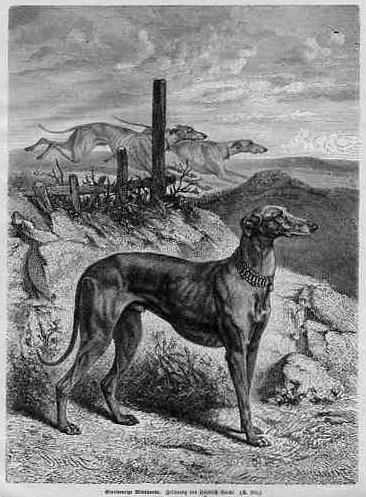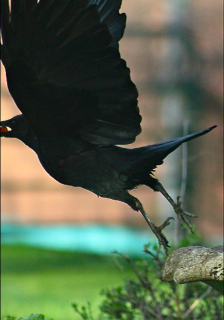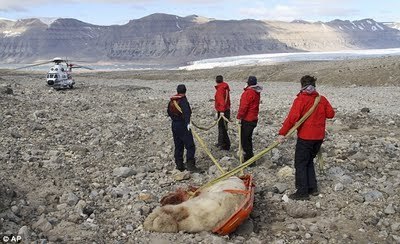Gordon Grice's Blog, page 85
August 16, 2011
Are dogs willing to eat the remains of their masters?

Are dogs willing to eat the remains of their masters? - By Brian Palmer - Slate Magazine:
"Dogs are perfectly willing to eat human corpses, and there's no evidence that they treat their masters differently than any other dead body. Many cultures consider dogs unclean precisely because of their tendency to scavenge our remains. In The Iliad, Homer makes nine references to dogs eating dead bodies. Dogs consumed the body of Jezebel, a princess in the Old Testament, after her defenestration. There is evidence that ancient Romans considered the low-hanging cross a crueler form of crucifixion than the high version, because it enabled dogs to rip the body apart."
The Iliad, in fact, begins something like this:
Goddess, sing of strong Achilles,whose vengeance broke uncounted evilson the Greeks. It sent the souls of heroes to Hell before their timeand, such was the will of Zeus,their bodies were left to the feasting dogs and birds of prey.
Published on August 16, 2011 10:54
August 15, 2011
Lynching a Pangolin

A Pakistani newspaper carried this odd item about a pangolin killed by superstitious villagers. As noted in the story, this is neither necessary nor constructive.
The pangolins (eight species in the primitive order Philodota, not closely related to anything else) is notable for having the longest tongue, proportionally, of any mammal. Its tongue is anchored in its pelvis and ribs, and when extended is longer than the rest of its body. It has no teeth, but grinds its food with a gizzard-like structure in its stomach. With the pangolin, evolution revisited the idea of scaly armor. This insect-eater is hairy, like most mammals, but the hair on its back mats together to form hard scales. Like the nine-banded armadillo, the pangolin can roll into a ball, presenting only its armored back to predators. It also knows more aggressive ways of countering an attack. It has stout claws, can lash its armored tail like a whip, and, like the skunk, sprays a repulsive fluid from an anal gland. It can also pinch an attacker between its scales. People have received minor injuries from these sundry defensive measures.
Another demonstration of the power of the pangolin's defenses comes from this recent news item, in which one pangolin meets a pride of lions.
Published on August 15, 2011 10:09
August 14, 2011
What Eats People, Part 14: Elephants
Croconut pointed me to this interesting report about an elephant killing 17 people. The scenario is familiar: people and elephants in competition for the same land and its produce. Elephants remember the places where they like to feed and will return to them even after months of absence. When they find a favored feeding spot infested with people, they may react the same way a human does when he finds ants eating food he things of as his. In this case, the humans killed the elephant's young, which may have led her to kill humans on sight. We don't know exactly how similar an elephant's emotional life may be to ours, but one interpretation here would be rage.
None of this is unusual. What's different about this story is that the elephant seems to have eaten human flesh. This sounds quite shocking, and of course this simple-minded TV show points up the abnormality of it. The truth is, we don't have enough context for evaluating this behavior. It may be that elephants have done this before; how often do their stomach contents get checked, even in cases of human death?
We do know that one of the elephant's many weapons is its bite. They have certainly been observed biting people. I often hear claims that herbivores simply don't eat flesh, but this is wrong and simplistic. Many animals will consume things outside their usual diet on occasion. Sometimes this is the result of a pica, an abnormal craving caused by nutritional deficiencies in the diet. It's the same reason some people feel a compulsion to eat dirt. The elephant's teeth are designed for grinding plant matter, but it has more than enough power to grind animal flesh if motivated. (Whether its stomach can actually digest this matter is another question.) In its January 12, 1948 issue, Time magazine reported this interesting behavior in a zoo elephant:
SWITZERLAND: An Elephant with Imagination - TIME: "One day, Chang brusquely snatched a doll from the arms of a little girl. For this he was banished to his pit. Then on a stormy November morning three years ago, zoo keepers saw blood on the floor of the pit. In Chang's straw bed they found a bloodied human hand and toe. The horrified keepers and police learned the unbelievable truth. Chang had devoured a young woman; he had swallowed her clothes, her hat, and even her large handbag."
This report, if true, lends some support to the pica hypothesis. Until recent decades, the nutritional needs of animals were not well understood, and they often suffered picas in captivity.
I don't actually think that's the cause of the anthropophagy in this recent case, however. This was not a predatory attack, but an adjunct to retaliatory violence. We know many other animals, even if not particularly disposed to take human flesh, will eat it once it becomes available—which happens if, for example, the animal itself happens to kill a human for non-predatory reasons. Domestic dogs sometimes kill a stranger who enters their yard, then eat him. This looks like violence incited by a territorial defense, followed by opportunistic eating of the body once it's dead. There's a well-known case of a photographer named Bill Tessinsky who apparently made a mother brown bear feel threatened. She killed him in defense of her cubs, then fed on the body. The elephant is obviously not a carnivore, and perhaps it's not subject to this same urge—but this one had been driven away from plant food. Her hunger may have led her to a dietary experiment.
So there's a possible scenario, and here's a wilder one. Eating is itself an aggressive behavior. One theory of human cannibalism is that it terrorizes survivors into flight or submission. To eat, or otherwise mutilate, an enemy is to advertise how dangerous you are to other enemies.
Previous Post in This Series
Published on August 14, 2011 09:22
August 13, 2011
Crows recognize and mob aggressive humans

Hitchcockian crows gossip about mean humans - Technology & science - Science - LiveScience - msnbc.com:
This article has a misleading title, since the crows are only attacking humans who have abused them. The exciting and new part is that the crows seem to communicate to other crows about which humans are dangerous.
"Even after going for a year without seeing the threatening human, the crows would scold the person on sight, cackling, swooping and dive-bombing in mobs of 30 or more.
'Most of the birds that are scolding us are not the ones we captured,' said study researcher John Marzluff, a professor of wildlife science at the University of Washington and an occasional victim of crow attacks. 'It's likely that they're learning from their parents and their peers that this dangerous person is still out there.'"
Related Post: Death Cycle Part 4
Photo by D'Arcy Allison-Teasley
Published on August 13, 2011 10:09
August 12, 2011
Woman Pets Tiger; Results Poor
UPDATE: Tiger attacks wildlife park employee - CBS 21 News - Breaking news, sports and weather for the Harrisburg -York -Lancaster -Lebanon Pennsylvania area:
"A woman is reportedly recovering from emergency surgery following a tiger attack at a Central Pennsylvania animal park, according to state police.
The victim, whose name has not been released, is an employee at the Lake Tobias Wildlife Park in Halifax Township, Dauphin County, park officials said.
After finishing her shift as a safari tour bus driver Thursday, the woman entered into a secure area beside the enclosure where two Bengal tigers live, according to the park manager. The woman apparently attempted to reach her arm into the tiger enclosure to pet one of the animals, which then clawed or bit her arm near her elbow."

"A woman is reportedly recovering from emergency surgery following a tiger attack at a Central Pennsylvania animal park, according to state police.
The victim, whose name has not been released, is an employee at the Lake Tobias Wildlife Park in Halifax Township, Dauphin County, park officials said.
After finishing her shift as a safari tour bus driver Thursday, the woman entered into a secure area beside the enclosure where two Bengal tigers live, according to the park manager. The woman apparently attempted to reach her arm into the tiger enclosure to pet one of the animals, which then clawed or bit her arm near her elbow."
Published on August 12, 2011 23:32
Cookiecutter Shark Scoops Human Flesh

A new report documents a case of the tiny cookiecutter shark, a type of dogfish, biting chunks out of a live human. This species typically takes bites from large fish and marine mammals, leaving them scarred but alive.
University of Florida News – New study documents first cookiecutter shark attack on a live human:
The species is small, with adults reaching about 2 feet, but their unique jaws specialize in scooping out a piece of flesh, leaving victims with a crater-like wound.
"Not only is it painful, but it presents a difficult circumstance for recovery in the sense that there has to be plastic surgery to close the wound and you have permanent tissue loss," said co-author George Burgess . . . . "It's very different from any other kind of attack we have in the International Shark Attack File because of the size of the shark and the modus operandi.""
Related Post: The Old Man and the Sharks
Published on August 12, 2011 10:20
August 11, 2011
Face Transplant for Charla Nash, Victim of Chimpanzee Attack
Visit msnbc.com for breaking news, world news, and news about the economy
I feel dirty posting anything from the Today Show, but here it is.
Earlier Chimpanzee Posts (including some about this case)
Published on August 11, 2011 15:49
Death of a Mule

Text and photography by guest blogger D'Arcy Allison-Teasley
Mule Gal and Mule Guy are neighbors, they are friends and they own the barn down the road where our mare is boarded. They are the sort of people who you call when your woods are on fire and they come immediately with tanks of water and shovels... and hugs.
I know because I did - and they did.
And, as you can guess from their nicknames, they love their mules.
They love horses, too.
But as Mule Guy points out, you can ride a horse to the edge of a cliff and say "jump" and a well-trained horse will. Do the same with a mule and the mule will say "you first." He swears their legendary stubbornness is simply a sign of superior intelligence.
Mule Gal is a reserved rider, a very sensitive, highly intelligent and intuitive woman who had a deep and rich relationship with her mule partner. She's no cowboy. He was no ranch horse. Trust was their theme, and they were a joy to see together. This mule had the demeanor of a gentleman, the patience of a saint, and the deep, dark eyes of an old, wise soul. And this mule loved his human.
Mule Gal's mule was struck and killed by lightning last night during a furious storm. I witnessed this same storm, from my place just down the road. I captured several pictures of the storm's dramatic lightning. It's entirely possible that one of the pictures I took is the strike that took this gentle mule's life.

Lightning is a frighteningly powerful force of nature.
A precious, beloved life - over in a flash. Literally.
But the heartache has just begun for Mule Gal.
Fortunately, friendship and healing are powerful forces, too. And Mule Gal has many good memories of her kind mule to help her smile through her tears.
Farewell to a Gentleman Mule.
You will be sorely missed, but never forgotten.

Related Post: Kansas City Lightning
Published on August 11, 2011 09:17
Monkey vs. Tennessee Law Enforcement
Very aggressive monkey attacks Tennessee woman | Reuters:
"Wilma Smith is in Bedford County Jail, serving time for manufacture of methamphetamine and weapons possession. Her husband had been caring for the monkeys."
Related Post: Patas Monkey Attack
"Wilma Smith is in Bedford County Jail, serving time for manufacture of methamphetamine and weapons possession. Her husband had been caring for the monkeys."
Related Post: Patas Monkey Attack
Published on August 11, 2011 02:06
August 10, 2011
More about the Norwegian Polar Bear

A somewhat sensational report with further details and photos:
The prowling, ravenous polar bear pictured a week before killing Eton-educated teen and seriously injuring four other Brits | Mail Online:
"It is believed that the flare-triggering defence systems in place at the BSES camp were faulty, which allowed the animal to enter the campsite early on Friday morning and being its attack.
Horatio, 17, was 'ripped to pieces' by the polar bear according to Patrick Flinders, who was in the tent next to the aspiring doctor when bear attacked."
Another link with more about the survivors
Published on August 10, 2011 12:51



